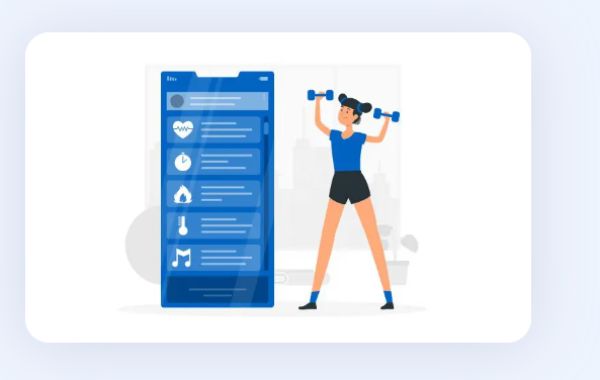Introduction
In today's fast-paced world, staying fit and healthy is a priority for many. With the surge in smartphone usage, fitness apps have become indispensable tools for individuals striving to lead healthier lifestyles. If you're passionate about fitness and technology, creating your fitness app could be a game-changer. This comprehensive guide will walk you through the process, from conceptualization to launch, empowering you to develop an innovative fitness app that resonates with users worldwide.
Understanding the Landscape
Identifying Market Trends
To create a successful fitness app, start by conducting thorough market research. Identify emerging trends, user preferences, and areas of opportunity within the fitness app market. Analyze competitors' offerings to gain insights into their strengths and weaknesses, helping you carve out a unique value proposition for your app.
Defining Your Target Audience
Understanding your target audience is crucial for app success. Determine the demographics, interests, and pain points of your target users. Tailor your app's features, design, and marketing strategies to cater to their specific needs, ensuring maximum engagement and retention.
Setting Clear Goals and Objectives
Before diving into app development, establish clear goals and objectives for your fitness app. Define what you aim to achieve, whether it's promoting physical activity, aiding in weight management, or offering personalized workout routines. Setting SMART (Specific, Measurable, Achievable, Relevant, Time-bound) goals will keep your development process focused and aligned with your vision.
Development Process
Creating a Prototype
Start by sketching out the basic layout and functionality of your app. Consider user flow, navigation, and key features such as workout tracking, meal planning, and progress monitoring. Prototyping tools like Sketch or Adobe XD can help you visualize your app's design and gather feedback from stakeholders before proceeding to development.
Choosing the Right Technology Stack
Selecting the appropriate technology stack is crucial for building a robust and scalable fitness app. Consider factors such as platform compatibility (iOS, Android, or cross-platform), backend infrastructure, database management, and third-party integrations. Collaborate with experienced developers to choose the most suitable technologies for your app's requirements.
Designing an Intuitive User Interface
A visually appealing and user-friendly interface is essential for enhancing the user experience of your fitness app. Invest in professional UI/UX design to create intuitive layouts, vibrant visuals, and seamless interactions. Prioritize simplicity and accessibility, ensuring that users can navigate the app effortlessly and achieve their fitness goals with ease.
Testing and Optimization
Conducting Comprehensive Testing
Before launching your fitness app, conduct rigorous testing to identify and rectify any bugs, glitches, or performance issues. Perform functional testing, usability testing, and compatibility testing across various devices and operating systems. Solicit feedback from beta testers and implement necessary improvements to ensure a smooth and error-free user experience.
Implementing User Feedback
Listen to your users' feedback and iterate on your app based on their suggestions and preferences. Continuously monitor user engagement metrics, such as retention rates, session durations, and feature usage patterns. Leverage analytics tools to gain actionable insights into user behavior and refine your app's features and functionalities accordingly.
Launch and Marketing
Creating a Buzzworthy Launch Campaign (H2)
Generate excitement and anticipation for your fitness app by orchestrating a compelling launch campaign. Utilize social media platforms, influencer partnerships, press releases, and app store optimization (ASO) techniques to maximize visibility and attract early adopters. Offer exclusive incentives or promotions to incentivize downloads and drive initial traction.
Scaling and Monetization Strategies
As your fitness app gains momentum, explore various monetization strategies to generate revenue and sustain long-term growth. Consider options such as freemium models, subscription plans, in-app purchases, or targeted advertising. Continuously analyze market trends and user feedback to optimize your monetization strategy and maximize profitability.
FAQs (Frequently Asked Questions)
How can I monetize my fitness app? There are several monetization options for fitness apps, including subscription-based models, in-app purchases for premium features, sponsored content, and targeted advertising.
What features should I include in my fitness app? Key features to consider include workout tracking, personalized training plans, nutrition guidance, progress tracking, social sharing capabilities, and integration with wearable devices.
How long does it take to develop a fitness app? The development timeline for a fitness app can vary depending on its complexity, features, and technology stack. On average, it may take anywhere from three to nine months to develop a fully functional app.
How can I ensure user engagement and retention? Focus on delivering valuable content, personalized recommendations, and interactive features that keep users motivated and engaged. Implement gamification elements, social sharing features, and community-building tools to foster a sense of belonging and accountability among users.
What are the legal considerations for developing a fitness app? Ensure compliance with data privacy regulations such as GDPR and HIPAA, especially if your app collects sensitive user information. Obtain necessary licenses or permissions for using copyrighted content, trademarks, or third-party APIs.
How do I market my fitness app effectively? Utilize a multi-channel marketing approach, including social media marketing, influencer partnerships, content marketing, email campaigns, and app store optimization (ASO). Target niche communities and fitness enthusiasts who are likely to benefit from your app's offerings.
Conclusion
Embark on your fitness app development journey with confidence, armed with the knowledge and insights shared in this guide. By following these strategic steps and staying attuned to user feedback and market trends, you can create a revolutionary fitness app that empowers individuals to lead healthier, happier lives.







